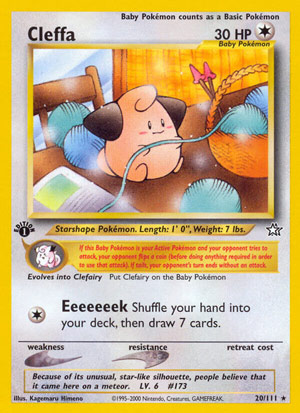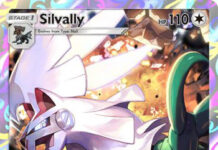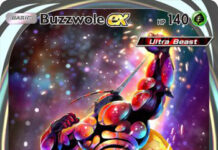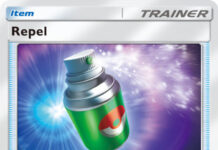
Cleffa – New Genesis
Date Reviewed: December 9, 2021
Ratings Summary: See Below
Ratings are based on a 1 to 5 scale. 1 is horrible. 3 is average. 5 is great.
Reviews Below:

Otaku
Today’s Throwback is Cleffa (Neo Genesis 20/111). Officially, this card originally released (along with the rest of Neo Genesis) on December 16, 2000. It was also recently re-released in Celebrations, using the original set’s symbol and card numbering, but with a 25th Anniversary stamp added. This Cleffa has been reviewed twice in the history of Pojo’s Card of the Day. On January 18, 2001, the original CotD reviewer Ness shared his thoughts on the card. Then, on April 11, 2007, the review crew of the time took a crack at it. Having missed that opportunity, today is my chance to share my thoughts on this card.
Cleffa was legal for last half of the 2001 Standard Format, as well as both the entire 2002 and 2003* Standard Formats. Some of you may be wondering what I’m talking about, because the term “Standard Format” has a confusing history. The term was coined to refer to the default format for Organized Play… which was originally Base Set through whatever was the newest expansion. When set rotation could no longer be avoided, players (including me!) got confused because we thought “Standard” meant the same as “Unlimited”, instead of the two merely overlapping. As of that first rotation and until the 2014 Standard Format, we instead referred to Standard Formats as “Modified” Formats. Many (most?) do not consider the Standard Formats prior to the first rotation to actually be “Standard” Formats.
With that out of the way, let us run through what Cleffa actually is. It is a Colorless type; while [C] Weakness and Resistance did exist at one time, it was after this card’s heyday. There were some anti-[C] effects, but they wouldn’t be the type that would matter to Cleffa. Cleffa has a Rule Box! This is because Cleffa is a special kind of Basic Pokémon known as a “Baby” Pokémon. This mechanic was introduced because the video game added “pre-Evolutions” to certain lines. In this case, Clefairy now evolved from Cleffa in the video games. The powers that be didn’t want to have to rotate out all the older stuff, but they also didn’t want to deal with some Clefairy being Basic while others were Stage 1, so they invented Baby Pokémon. Baby Pokémon are still Basic Pokémon, following the same rules for putting them into play and having to deal with the same effects. Please note that the term “Baby Pokémon” has been used informally for pre-Evolutions since the days of Neo Genesis, but the only true Baby Pokémon were released in the Neo series and e-Card series.
Below the Rule Box, it states that Cleffa Evolves into Clefairy (and features an image of Clefairy), the way most Evolutions have an “Evolves from” box. It also says to just put Clefairy onto Cleffa (if you wish). Okay, so what does the Rule Box say? It states that, when your opponent tries to attack while this Pokémon is your Active, your opponent must flip a coin. This is done before any other things required to use your attack. If your opponent gets “heads”, the attack proceeds as normal (and you do anything the attack requires). If “tails”, the attack fails. Your opponent’s turn automatically ends! The “Baby Rule” as it was called proved to be a powerful stalling tactic.
Yes, even though Cleffa only has 30 HP! This is the minimum printed HP score for a Pokémon. It lasted longer back then in the sense that it took a turn or two for decks to do a reliable 30 damage, but it didn’t last as long in the sense that the only Turn 1 restriction during Cleffa’s Standard-legal run was no manually evolving. There were first turn attacks and first turn Supporters (at least, once Supporters were added during the 2003 Standard Format). Cleffa’s 30HP meant the lack of Weakness and Resistance rarely mattered. The free Retreat Cost, though… that was great! It helps to know at this time, you could retreat as many times as you wanted (and could afford) during a turn. This made pivot Pokémon a bit more valuable.
Cleffa knows only a single attack, but it is a good one. Well, it was a good one, anyway. Priced at [C], Cleffa could use “Eeeeeeek” to shuffle your hand into your deck and draw seven cards. This was perhaps the primary source of draw power early game. At least in Standard; in the Unlimited Format, it was your best shot at recovering if your opponent pulled off a Turn 1 Trapper* combo or Lass. Of course, an opposing Cleffa (or other Baby Pokémon) was the easiest way to counter Eeeeeeek as well. Cleffa wasn’t as vital mid-to-late game, but it did act as insurance, in case your hand was obliterated at a later point. Its HP was sometimes a problem when it was on your Bench, as the Baby Rule didn’t protect it there.
Maybe Cleffa sounds underpowered, so let us discuss the rest of the metagame a bit. Supporters wouldn’t be released until the Expedition expansion on September 15, 2002. While the Unlimited Format still had crazy powerful draw and search like Professor Oak and Computer Search, it also had some crazy powerful anti-Trainer effects, including the second ever card banned from the Standard Format: Slowking (Neo Genesis 14/111). If you needed to draw while dealing with such things, Cleffa was your best bet. Slowking wasn’t banned in the Standard Format until the end of 2002, so this was also true for about half of its Standard-legal run. Even without having to deal with Slowking or similar (but less powerful) cards, the best draw Trainer at the time was Professor Elm.
Professor Elm was not a Supporter, as they hadn’t been invented yet. It had you shuffle your hand into your deck, then draw seven cards; you couldn’t use any Trainers for the rest of that turn, though. Still, since it functioned like an Item, it was still very good. Just not as good as what we’d known before (Computer Search, Professor Oak, etc.) When Supporters were finally introduced, it took some of the pressure off of getting that opening Eeeeeeek, but it and Professor Elm still saw a lot of play and that made early Supporters like Copycat much better than they otherwise would have been. Not every deck ran Cleffa, but most did. Even if they might want to lead with something else, they probably still had a Cleffa or three.
There’s one last, important trick that all Baby’s tended to use: Focus Band. Well, almost every attacker wanted to have it attached while it was legal, not just Babies. It is just that it was extra insidious on them, because Focus Band was a Tool that let you flip anytime the Pokémon with it attacked would be KO’d by damage. If “tails”, Focus Band did nothing. If “heads”, instead of being KO’d, that Pokémon survived with 10 HP left. The only thing keeping it from being completely broken, besides the slower pace of the game, was that Focus Band did discard itself after it used its effect. Still, even with a decent attacker, OHKOing a Cleffa with a Focus Band meant needing to flip “heads” on the Baby Check and your opponent flipping “tails” on their Focus Band check. Discarding an opponent’s Tools was very difficult back then; only certain attackers could do it!
Cleffa was easily a four-out-of-five or a five-out-of-five when it first released, and was at least a four-out-of-five when Neo Genesis finally rotated from the Standard Format. Would it be any good now? Maybe. It definitely isn’t as good as it once was. If you go first, you cannot attack your first turn. An Active Cleffa would prevent your opponent from making a successful attack Turn 2, but they might not even be that focused on attacking so quickly. Even the ones that are could use Escape Rope (unless you have another Cleffa on the Bench) or Boss’s Orders (unless you only have Cleffa ont he Bench, or no Bench at all) to get around the Baby Rule. Cleffa can no longer provide Turn 1 draw, as Player 1 cannot attack on their first turn.
If you use Cleffa to attack Turn 2, that could work but… we’re in a metagame that is great at spreading damage counters. Including from non-attack effects; the Baby Rule only protects against attacks while that Baby is Active. On the Bench, or when being hit by Abilities (though back then, it would have been Pokémon Powers), and all they have is their 30 HP. I don’t think it would stand much of a chance, but I’ve been wrong plenty of times.
Ratings
- Standard: N/A
- Expanded: N/A
*Remember, Standard Formats – at least in the present – are named after the year in which they end. So the 2003 Standard Format began mid-2002 and ended mid-2003.
**The Trapper combo was an opponent using Imposter Oak’s Revenge to shrink your hand to four cards, Rocket’s Sneak Attack to force you to shuffle any Trainers you had in your newly shrunken hand into your deck, and finally finishing you off with The Rocket’s Trap. While that last one required a coin flip, it was a “normal Trainer” (Item card) that forces your opponent to shuffle three cards from their hand into their deck!
We would love more volunteers to help us with our Card of the Day reviews. If you want to share your ideas on cards with other fans, feel free to drop us an email. We’d be happy to link back to your blog / YouTube Channel / etc. 😉
Click here to read our Pokémon Card of the Day Archive. We have reviewed more than 4700 Pokemon cards over the last 21+ years!



